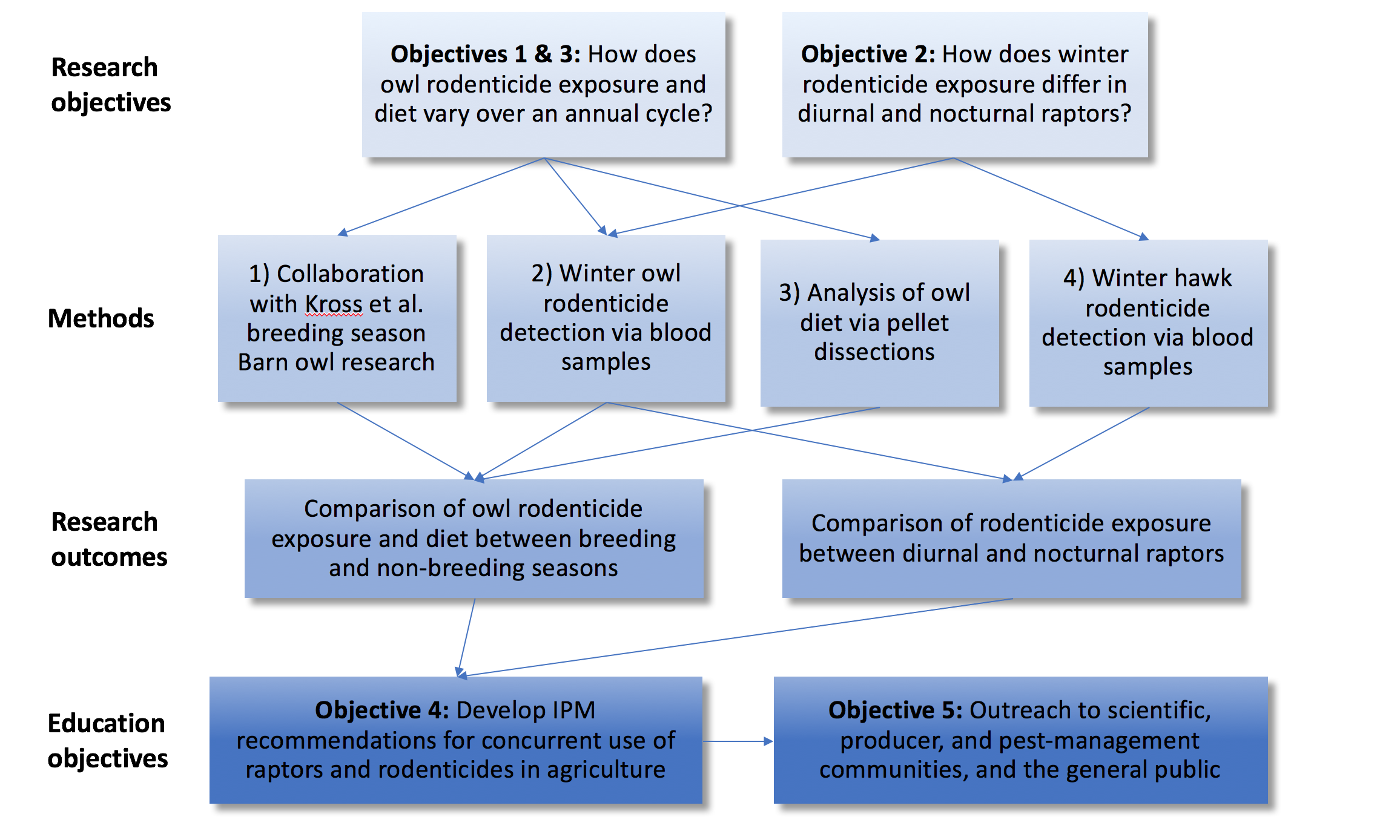Project Overview
Information Products
Commodities
- Agronomic: hay, medics/alfalfa, sunflower
- Fruits: grapes, olives, plums
- Nuts: walnuts
- Vegetables: tomatoes
- Additional Plants: herbs
Practices
- Education and Training: demonstration, display, extension, networking, on-farm/ranch research, technical assistance, workshop
- Natural Resources/Environment: wildlife
- Pest Management: biological control
Abstract:
We investigated the frequency of secondary exposure to rodenticides in raptors that provide natural pest control on farms in the Western United States. In the agricultural landscape, the majority of a raptor’s diet consists of rodent pests, that can reduce yields and damage infrastructure. Integrated pest management (IPM) strategies for rodent pests frequently incorporate natural pest control provided by raptors, however, rodenticides are often applied concurrently. Rodenticide exposure can cause lethal or sub-lethal secondary poisoning in raptors, ultimately lowering the pest control they provide and increasing farmers’ need for rodenticide use.
We have little understanding of how rodenticide exposure in raptors varies across seasons and between species in agriculture. Furthermore, studies to date have focused primarily on spring and summer months for both understanding the role that raptors play in providing pest control and for monitoring rodenticide exposure—whereas both occur year-round. To address these knowledge gaps, we investigated rodenticide exposure rates in hawks and owls across multiple seasons and as a function of proximity to rodenticide application sites to answer two critical questions: 1) How does barn owl rodenticide exposure and diet vary over an annual cycle? 2) How do rodenticide exposure rates compare between diurnal and nocturnal raptors?
To accomplish this task, we collaborated with ongoing barn owl research projects (SW18-063), pest management specialists, raptor biologists, and producers who are interested in developing data-driven management recommendations for raptors and natural pest control in agriculture. We conducted extensive outreach to academics, professionals, farmers, and the general public, all who stand to benefit from the results of this study. We directly reached over 250 farmers and agricultural professionals with management recommendations and worked alongside of multiple land managers to develop and/or enhance barn owl box networks with the goal of increasing natural pest control in agriculture. Our ultimate objective is to enhance the understanding of simultaneous use of raptors and rodenticides in agriculture on a year-round basis and communicate IPM recommendations to a wide audience.
We tested the blood of hawks and owls for circulating anticoagulant exposure to detect recent sublethal exposure (from the past 1-2 weeks depending on dose and compound). The results of our study indicated low rates of acute anticoagulant rodenticide exposure in barn owls across seasons, although we also documented low rodenticide use at our study sites during the study period. We found that non-breeding red-tailed hawks were exposed to anticoagulant rodenticides more frequently than barn owls at our study site, with red-tailed hawks across all years having a 15% (5/34) positivity rate. While these results suggest low acute exposure rates to anticoagulant rodenticides in raptors on farms, these results must be interpreted with caution. Because we wanted to study the interaction between raptors and the normal pest management approaches on farms, we did not influence the applications of rodenticides, and therefore sampling did not necessarily align with locations or timing that baiting occurred. Further research is needed where sampling is closely coordinated with the timing and locations of field-scale baiting or in landscapes with higher prevalence of buildings and facilities where second-generation anticoagulant rodenticides are regularly used.
Project objectives:
Objectives:
- Quantify differences in rodenticide exposure frequencies in wintering and breeding barn owls.
- Quantify differences in rodenticide exposure frequencies between wintering diurnal (red-tailed hawks) and nocturnal raptors (barn owls).
- Describe the diet of overwintering barn owls.
- Create stakeholder-verified recommendations for the use of rodenticides and raptors for effective IPM systems for rodent pests, in conjunction with Kross et al. ongoing barn owl–rodenticide research.
- Publicize findings through to the scientific community, producers, and the general public through presentations, publications, and field workshops.
Our project is closely coordinated and in collaboration with an ongoing Western SARE project (SW18-063) investigating impacts of barn owls and rodenticide exposure on sustainable agriculture in the breeding season. Our project adds two additional components to the ongoing project. First, it will help provide a complete year-round picture of the interaction of rodenticides and raptors in an agricultural context. Second, it will provide a comparison of rodenticide exposure rates in a second group of raptors (diurnal red-tailed hawks). Diurnal raptors provide a large portion of pest control services on farms, especially in winter months, and may experience different rodenticide exposure rates than nocturnal raptors.
Figure 2: Flowchart of interaction between project objectives, methods, and outcomes.
